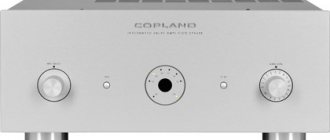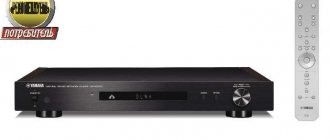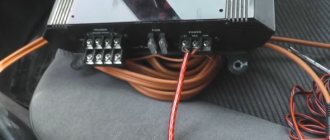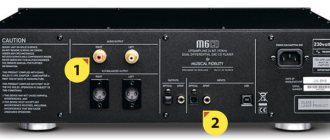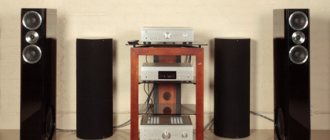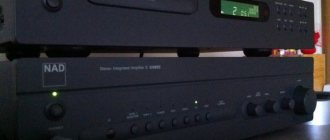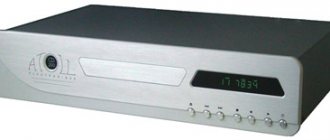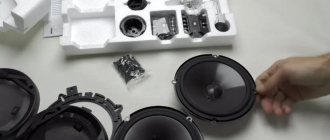Copland CSA100 integrated amplifier
Here's a new example of bold engineering: this amplifier combines the advantages of tube and solid-state amplification, with the latter implemented using bipolar and field-effect transistors. And in general, the new product is for all occasions: it has its own DAC on the ESS Saber ES9018 chip and a phono stage for MM heads. Let's test this station wagon in full - in different modes with several sources.
The Danish brand Copland has always been famous for its designs with classical circuitry and impeccable execution, which has achieved a predictable result in terms of sound. If we talk about the new development, the CSA100 integrated amplifier, then everything is not so simple. Six years ago, Olé Möller, the founder and chief designer of the company, when asked by our magazine if he was going to abandon hybrid circuitry, replied: “Of course not. Copland is expecting new hybrid amplifiers in the future. The fact is that such a principle is not so easy to implement. The main goal in this case is to take the best of both technologies, tube and transistor, but we must remember that the opposite result is also quite likely.”
The input section is tube-based, built on a low-noise double triode 6922. From the same stage, the signal is supplied to the linear output.
By the way, let me remind you who Ole Müller himself is. His career began about 50 years ago in the R&D department of Ortofon. He opened his own business in 1984, and by the early 90s the Copland brand became known throughout the world. The modest-sized production is located in Copenhagen; all equipment is assembled by hand by qualified craftsmen.
As stated above, there is a risk of failure when designing hybrid amplifiers, but the CSA100 takes every precaution to avoid this. The input section is tube-based, built on a low-noise dual triode 6922. From the same stage, the signal is supplied to the linear output, so if desired, you can expand the system architecture by connecting a subwoofer or an additional power amplifier.
In order not to lose the speed and signal range specified by the triodes, they are followed by cascades on high-voltage MOSFETs - field-effect transistors with a “tube” characteristic. They also provide coordination with output repeaters on complementary bipolars MJL4281A/MJL4302A. These 230 W transistors are not parallel - they operate one in each arm.
Pay attention to the power section of the amplifier. In terms of weight and dimensions, a toroidal transformer draws 800 watts, no less, and the total capacity of the smoothing capacitors is 60,000 μF. On the heat sink, in addition to the output transistors, there is a temperature sensor connected to the protection system. The output power of the CSA100 is 2 x 100 W into an 8-ohm load and 2 x 180 W into a 4-ohm load.
The built-in DAC is based on the well-known DAC215 converter on the advanced Saber Reference ES9018 chip. Its eight output cells are connected four in parallel in each stereo channel, which gives a linear phase response, distortion of the order of 0.004% and a noise level of -120 dB. When connected via asynchronous USB, the DAC supports PCM with sampling rates of 44.1 - 384 kHz and bit depth up to 32 bits, as well as DSD 2.8 - 5.6 MHz (64 - 128x), DSD256 and DSD512. USB receiver – Amanero with DAC clocking.
The built-in DAC is based on the well-known DAC215 converter on the advanced Saber Reference ES9018 chip.
In addition to USB, digital sources can be connected via coaxial and two optical inputs. There is also room at the back for installing an optional Bluetooth module. The most interesting thing is that for digital switching there is a separate switch with a small knob on the front panel, and a second, larger selector is responsible for selecting analog inputs. There are five of them: PHONO, TAPE IN, A1, A2 and balanced on XLR. The active input is indicated by a dim blue light on the round dial in the center.
The phono stage, judging by its appearance, is quite simple, however, in terms of sound it did not turn out to be a weak link at all. But I will talk about this separately.
Headphones are connected via a 6.3 mm jack. The volume control is a typical Copland motorized potentiometer with a digital scale on the skirt. CSA100 is available in black and silver versions.
The first sound check is on the analog input, Naim NDX2 source, connected via Ethernet to a NAS server with music. Acoustic systems – small floor-standing Totem Forest Signature. The sound is smooth, balanced, with precise nuances. I find on the server and add the tracks Dio, Anthrax, Guano Apes and Korn to the playlist, and turn up the volume. There is no confusion, there is no confusion, everything is legible, but somehow a little detached, although there is more than enough drive. It’s about the same with classical music – all the instruments are perfectly identifiable by ear, the scale of the orchestra is convincing, but there are no bright colors or sparkle in the presentation.
On some soundtracks a powerful infra-low component is noticeable; it is surprising that speakers of such a modest caliber are capable of going to such depth.
We switch from the linear output of the streamer to coaxial, and through the BNC/RCA adapter we supply the signal to the built-in DAC of the amplifier. This is where real emotions begin to appear, and the space expands in volume. The sound becomes brighter and more contrasting, so listening to music is already interesting. On some soundtracks a powerful infra-low component is noticeable; it is surprising that speakers of such a modest caliber are capable of going to such depth. The resolution of timbres, especially in the upper band, has increased noticeably. The cymbals sparkle with real silver, the saxophone has a wide harmonic spectrum. Whatever genre you choose, everything sounds lively and attractive.
The next stage is the Lumin U1 Mini streamer connected to the amplifier with a serious Tellurium Q USB cable. The source is the same NAS. And this is where the real celebration of life begins. The feeling that the music is being reproduced by the equipment disappears almost completely. It is clear that the speakers are playing, but what is happening in the sound stage is not tied to them and exists as if by itself. Dynamic contrasts are sharper, there is much more life in the music, the orchestra is like an avalanche, consisting of a mass of harmoniously composed sounds. The overall dynamics are adequate for a room of 25 - 30 meters, sharp peaks are transmitted without distortion, and there are many vivid details in the overall picture.
And this is where the real celebration of life begins. The feeling that the music is being reproduced by the equipment disappears almost completely.
Now we connect the Transrotor Rossini turntable with a TR 800-S tonearm and a Uccello MM head to the PHONO input. Nina Hagen, "Fearless", original 1983. Powerful, bright, with character. Rich frequency spectrum, the entire breadth of the vocal range - in full view. A real performance. Rage Against the Machine Anniversary Edition on 180 gram vinyl. Pressure, energy, deep bass with a quick alternation of beats that are perceived not only by the ears, but also by the body. In three-dimensional sound interweavings, every instrument, every note is read. It’s a rare feeling that the music is playing just for you, it literally pulls you in. To turn off the system, you need to overcome some effort, but you still have to do it.
It is known that in modern music the most interesting things appear at the intersection of genres, when different styles and directions are mixed. Approximately the same thing happens in technology, and the result also depends on the talent of the author - and we have just seen this ourselves.
COMPONENTS
- Naim NDX 2 Network Player
- Network player Lumin U1 Mini
- Vinyl turntable Transrotor Rossini
- with TR 800-S tonearm and Uccello head
- Speaker systems Totem Acoustic Forest Signature
- Puritan Audio Laboratories PSM 136 surge protector
- Speaker cable Tellurium Q Blue Diamond 2m
- Tellurium Q RCA Ultra Black II Interconnect Cable
- Tellurium Q Digital RCA Black Waveform Digital Cable
- Tellurium Q Statement USB Digital Cable
- Network cable (Copland, Lumin) Puritan Main Cable 1.5m
- Network cable (Naim NDX 2) Naim Power Line 2m
Copland CSA 100
Manufacturer: Copland (Denmark)
www.copland.dk
Analogue inputs: 2 x RCA, Phono, XLR || Analogue outputs: 2 x RCA, headphone, acoustic screw x 4 || Digital inputs: asynchronous USB (32/384, DSD512), S/PDIF(RCA), Toslink || Amplified frequency range: 10 Hz – 150 kHz || Output power: 2 x 100 (8 ohms), 2 x 180 W (4 ohms) || Signal to noise ratio: > 90 dB || Harmonic distortion: <0.06% || DAC: ESS Saber ES9018 || Power consumption: 700 VA || Dimensions (W x H x D): 435 x 135 x 370 mm || Weight: 14 kg || Price: 380,000 rub.
You can listen to the Copland CSA100 amplifier in the Moscow InSound .
share
Tags: CoplandCopland CSA100Expert's choice
Copland CTA-405-A Black
The Danish company Copland has long been known in our country to lovers of high-quality sound. Its products are an example of not only a competent design approach and careful selection of components for its products, but also a correctly chosen strategy and the right moment to enter the market. Or maybe there was some basic luck involved. How many noteworthy designs never saw mass production! Nevertheless, new stars appear in the heavens, and new schemes and solutions are maturing in the depths of design bureaus. The laws of nature require updating, rivers change their courses, companies delight us with new designs that should bring us an iota or two closer to the ideal. This is natural, and we are latently prepared for this.
There are few external differences with the already familiar STA 405, and they are immediately visible. The alphanumeric designation, enriched with the first letter of the alphabet, moved to the second line in the center of the inscription and acquired a carmine hue, like the “ST.BY” button. That seems to be all. Well, except for the word “stereo” at the beginning of the line, which is why the title “moved out”. Not enough for an updated look. On the other hand, decorum is maintained, and inside we have two pairs of KT120 in the output stage, a built-in low-noise Sanyo Denki exhaust fan, screwed to a horizontal plate of exactly the same carmine color. And in this one can discern some special chic, inner sophistication. It's as if, instead of chrome-plating the bumper of a classic car, the manufacturer decided to turn the driveshaft from the inside into a mirror. You can also remember Freken Bock’s insoles, which she urgently wanted to buy before going on television. In a word, this is something hidden from prying eyes, but at the same time carrying a special meaning. In any case, the meaning of anodizing an internal structural element in such a non-trivial color escaped me. It’s absolutely true that the fan is low-noise. Firstly, it is low-speed, with a rated speed of 2000 rpm; secondly, the manufacturer claims the noise level is 16 dB. Of course, you can hear it with the top cover removed and the volume level at zero, but when assembled it does not remind you of itself in any way. And although the combination of a class A amplifier (which, according to the manufacturer, is what the Copland CTA 405-A is up to about half its power) and a fan may seem controversial to many (by the way, it was not present in the previous model), but, apparently, This is the only way to ensure acceptable thermal conditions without resorting to serious alteration of the appearance.
At the back wall there is a small board, which I initially mistook for a phono preamplifier board (which is not surprising, since it is on it that its input jacks are located), but the inscriptions on the connectors of the cables going to the volume control force us to make an unambiguous conclusion that this is also at the same time preamplifier board. It houses a pair of 12AX7EHs and a pair of 6922EHs, all from Electro-Harmonix. The latter tube is a fairly close analogue of the 12AX7, which in turn are the favorite choice of a wide range of manufacturers of preamps, phono stages, headphone amplifiers, etc. In a word, I would not dare to say without disassembling and studying the board layout which lamps act as preamplifier stages and which ones are responsible for correction, but no one demands this from us. It's funny that due to the design, the phono stage uses more serious connectors than all the others. The Copland CTA 405-A main board contains a 290 VA toroidal power supply transformer from Noratel. The output transformers are not marked, but visually they are 100% identical to those installed in the base model.
The power amplifier section consists of a 12AX7EH dual triode (which serves both channels simultaneously), a pair of 12BH7AEH bass reflex drivers, which have thicker glass and therefore reduced microphone effect, and a quartet of KT120 beam tetrodes from Tung-Sol.
As for the selection of lamps, it cannot be called unusual; on the other hand, intermediate stage lamps are not exactly the most common, which again suggests some design preferences that are not so noticeable at first glance, but are quite critical from a sound point of view. To switch inputs, Swiss Axicom relays are used, located in close proximity to the connectors themselves. The board is generously strewn with Jamicon film capacitors, which do not need to be introduced once again to those for whom life is not complete without a sip of coffee and a haze of rosin.
The front panel design of the Copland CTA 405-A is strict and balanced. The 100% symmetry of the aluminum plate makes me wonder if the through channel button was left in its place solely for the sake of this symmetry? Although, in my opinion, this rare function was left deliberately. How it fits into the style of a real “seasoned” sound. As an aim at the target audience, for whom handling the recording level control is not such a distant past.
The central element of the panel is a kind of target, with a “bullseye” - an IR radiation receiver behind dark glass and an input selector indicator located around the circumference.
It looks, despite its apparent simplicity, stylish, original and very organic. The remote control in an aluminum case is moderately weighty and allows you to control not only the amplifier itself, but also the CD player. Copland CTA 405-A is a great amplifier, as they say, for all occasions. It fully possesses all the musical advantages that brought well-deserved fame to this Danish manufacturer. The quality of its execution is close to ideal, and personally I only regret one thing: that the manufacturer decided to hide the lamps from the eyes of future owners under an almost blank cover. Does it have any disadvantages? Yes, perhaps, only one: owners of CTA 405 risk being very upset.
Characteristics of Copland CTA 405-A
Tubes: 6550 (4pcs) 12BH7 (2pcs) 6922 (2pcs) E83CC (3pcs) Output Power: 50W per channel THD: <1% Frequency Response: 10Hz-100kHz (-3dB) Input Sensitivity: Phono: 3.5 mV Line inputs: 350 mV Input impedance: Phono: 47 kOhm Line inputs: 33 kOhm Load impedance: 8 Ohm, 4 Ohm Signal-to-noise ratio: > 95 dB Power consumption: 250 W Supply voltage: 115V or 230V. Factory set according to country of destination Supply voltage tolerance: +/- 12% Dimensions (mm): 430 (W), 185 (H), 390 (D) Weight (packaged): 25 kg
Yesterday one of our many and dear clients came to purchase an acoustic cable, having first listened to it. The choice fell on TelluriumQ Ultra Black II after a long conversation and a thorough analysis of the system. This process resulted in listening to the Copland 405A integrated circuit and, as a result of the system on the 405, AudioVector QR5, Bryston BCD-3 CD player connected into the system with a TelluriumQ cable. The interconnect cable was TelluriumQ Black RCA. I initially connected the AudioVector to the Musical Fidelity M6 500i. True, it was the day before yesterday, when another, no less expensive client came to us to listen to a set of jazz and classical music. The budget was set at 500 thousand rubles +/-. The speakers and amplifier were connected using a TelluriumQ BlackII cable, the signal source was a Cambridge Audio Azur 851N. We listened to tracks from Tidal and FLAC from a USB drive. I really liked the sound. The system was rocked (the amplifier and speakers were practically new) with DEEZER from Heos Link. The clear conclusion is that insufficient quality material when playing on the system simply kills it. With USB and Tidal the situation is completely different. After 2-3 hours the speakers started playing very, very interesting. Briefly about our system. Amplifier - English manufacturer, dual mono system. Power transformers, smoothing filters (four capacitors 6800 μF x 100V each) and separate rectifiers for each channel. The amplifier delivers 500W (27dBW) to an eight-ohm load, thanks to 12 MOS field-effect transistors (MOS) per channel, connected in parallel in each channel. The transistors are installed in the side heat sinks - impressive radiators. You can connect the source via a balanced input, it is possible to use the amplifier as part of a home theater as a power amplifier (you will need to reassign AUX to HT. Now about the acoustics. The famous Danish manufacturer is an innovator. The case is made flawlessly, the joints are perfect. Very beautiful (in our The showroom has a white model, there are also options in black piano lacquer and trimmed with dark walnut veneer.) Ribbon tweeter (Air Motion Transformer), which pushes air five times faster than conventional planar drivers, thanks to the compression and stretching of a very thin fluoroplastic tape with aluminum coating, which folded like an accordion. With this design, the material is of poor quality and does not play. To combat this phenomenon, the designers installed a gold-plated metal mesh covering the tweeter to restrain the sound flow. A 6-inch speaker plays in the midrange range, and two also six-inch speakers in the low frequencies, but with more impressive double magnets and having baskets designed for an increased diffuser stroke length. Diffusers are a sandwich of two layers of the finest aircraft-grade aluminum and a damper layer between them. Optimally light, quite rigid. The midrange driver is placed in an isolated chamber. The bass drivers work in a design - a bass reflex, the slot port of which is located in the gap between the bottom of the body and the support platform. Q-port is a proprietary development of this bass reflex by Audiovector. The speakers are connected using a singlewire scheme. Cambridge Audio 851N network media player. This is not only a streaming player with support for Spotify and Tidal, AirPlay, Internet radio, but also a DAC and preamplifier. DAC based on Analog Devices AD1955, which operate in dual mode, Bluetooth support (BT100 adapter sold separately). The power circuit contains a powerful toroidal transformer. USB inputs for connecting flash drives and HDD (type A), USB-B input for connecting a computer (you need to switch to 2.0 mode in the settings. Digital interfaces of all main types, both input and output. The device can be connected via balanced analog output to the amplifier. There is a small peculiarity. After I took it out of the box and connected it to the amplifier, I discovered that there was no sound (I connected it analogue). So, through the menu, you need to disable the digital mode of the preamplifier. On the front panel, the 4.3-inch is beautiful and information display. You can control the player either from a standard remote control or from the very, very convenient Cambridge Connect application, which works with both Android and iOS platforms, and can be installed on both a tablet and a smartphone. The system requires a long warm-up ( touches the amplifier). The band played powerfully and dynamically. The scene was depicted flawlessly both in width and depth. There is no shortage of detail. The female vocals are at their best. We listened to Your Heart Is As Black As Night from Melody Gardot, Oscar Peterson, Blues Company, Leonard Cohen. Judas Priest Monster of Rock, the entire album Firepower played powerfully, energetically, the bass attack of Ian Hill, the guitars of Tipton and Faulkner, and of course the vocals of Rob Halford, were immensely pleasing, I just didn’t want to turn it off. Muter by Rammstein listened to the entire album with great pleasure. So what is the second system? We immediately changed the source to Bryston BCD-3. The material was as follows: Jheena Lodwick All My Loving, Victor Feldman Audiophile from JVC, Antonio Forcione & Sabina Sciubba Meet me in London from Naim. The CD player is good. It is made of very high quality, the drive is different than before and with which questions arose. DAC based on dual AK4490. Independent power supply for digital and analog parts. Everything worked just as well as in the previous system. Highest resolution, amazing detail. But the miracles began after replacing the M6 500i with a Copland 405A. I haven't listened to a better combination in a long time! Every sound filled the entire room, a real feeling that I was at a concert. Charged with positivity for the entire coming weekend. The female vocals were especially pleasing. Every sound of the instruments was heard. Copland revealed AudioVector to the maximum, acoustics showed everything that it is capable of. We were able to compare the new TelluriumQ Ultra Black II and TelluriumQ Black II. Ultra sounded more thoroughbred, more delicate, more detailed. The bass component and lower mids proved to be much more interesting. You can listen to all this in our showroom, you just need to book it in advance. The flow of clients is now large, so that there are no overlaps and the audition is very comfortable.
